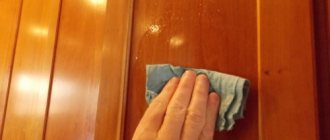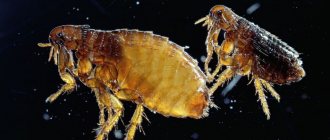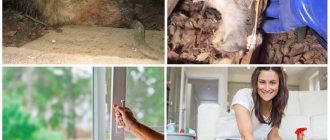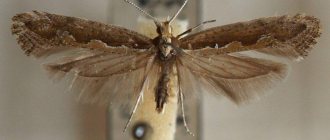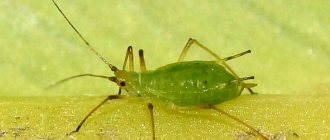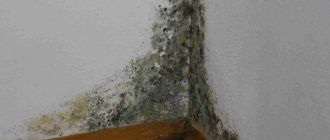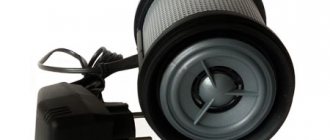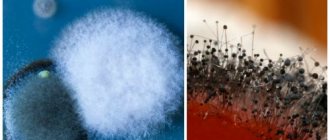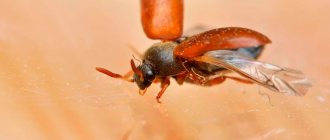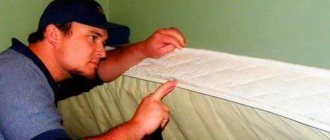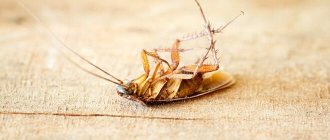Harm and types of mold
Microbiologists know more than 150 thousand mold microorganisms. Some types of fungus are often found in the house, which can be easily distinguished from each other by color.
Mold quickly takes over the space
Greens
Penicillium fungi, with a moss-like color and lumpy, loose surface, occasionally form on furniture, brick and concrete. Often found on spoiled products. They cause neoplasms, bronchial asthma, and cirrhosis of the liver. This species became the ancestor of the penicillin group of antibiotics, and is therefore considered noble.
Penicillium
White
Mucor fungus grows when plants are watered abundantly. The development of a whitish coating is provoked by increased temperature and dampness in the apartment, uncontrolled fertilizing with compounds containing nitrogen. Sometimes it reproduces on fruits and vegetables. Propagation stops at temperatures below -8℃.
Mucor
Pink
They affect grain, root crops, as well as the top layer of surfaces, without penetrating deeply into the structure of materials. This pathogen is easier to deal with than others.
Pink mold on the wall
Yellow
Cover damp walls, wallpaper, plaster. Found on fish, bread, and dairy products. Harmful microorganisms cause severe allergic reactions, liver dysfunction, and gastrointestinal tract.
Yellow mold on wood
Orange
Highly toxic fungi appeared as a result of mutation of other micromycetes. They settle on damp walls and spoiled food. When it appears, it resembles a pasty coating. Later it dries out and looks like rusty powder. It starts to smell unpleasant.
Orange micromycetes
Blue
A cloudy blue Ceratocystis fungus takes up residence on a tree. Covers furniture and parquet. Destroys the coating, forms cracks in which moisture accumulates. In such a favorable environment, pathogens are formed.
Blue fungus
Black mold
The most common species, settling on any materials. If Aspergillus Niger is not dealt with, your health may deteriorate: insomnia, headache, and a feeling of constant fatigue appear. Sometimes serious illnesses develop.
Aspergillus Nigeria
Mold in an apartment destroys wooden, concrete, and plastic coverings; causes metal corrosion. Damages textiles and leather items - clothing, furniture, accessories. Dangerous microorganisms infect products. Destroy paper media - documents, books.
The spores worsen health: they cause allergic reactions, diseases of the hair, nails, and skin. In severe cases, bronchial asthma, pneumonia or aspergillosis, a fungal disease of the lungs, develop. Toxic compounds found in mold sometimes cause rapid development of cancerous tumors.
Types of mold
Mold stains that often appear in the home come in several varieties.:
- Whitevine - most often found in flower pots due to overwatering or using too much fertilizer
- Green vine - often found on building materials
- Black mold - this fungus appears in apartments and houses more often than others. It has subspecies. A common feature they all have is color, which appears at a certain stage of development. It also matters on what surface the mold settles.
- Blue mantle - often forms on wooden surfaces, gives them a milky blue tint and dissolves the varnish layer;
- Rotting mold is also the most common contaminant of wood, causing it to disintegrate and turn gray or brown.
The possibility of detection depends on how far the mold has spread in the indoor air and settled on surfaces, acting from the very beginning in the air. Most often these are cough, nausea, shortness of breath and chronic diseases that are difficult to diagnose. It can also cause nausea, headaches and fatigue.
These are all the result of being in a damp room full of mold. Therefore, it is important to fight it in a timely manner, as soon as its manifestations appear. There are many options to fix it.
Causes of mold formation
Microscopic mold spores get from apartment to apartment with plants, on pet hair, and clothes. The spores are carried by air currents and, when they land on damp surfaces, begin to germinate. Mold develops intensively in a nutrient medium - on wood, in flower soil, paper, brick and concrete walls.
Flower soil is a complete nutrient medium for micromycetes
Fungi easily adapt to their environment, but the necessary conditions for the appearance and development of molds are known:
- increase in air temperature from +20℃;
- excess carbohydrates;
- leaking water pipes or roof;
- high (from 75%) humidity;
- freezing of walls;
- poor ventilation;
- soil dampness;
- depressurization of windows;
- insufficient heating of the apartment.
If these conditions are met, then mold at home begins to multiply intensively on products and materials - rubber, carpets, linoleum fabric base, plastic and even concrete. Dirt in the apartment provokes the appearance of bacteria, and along with them, fungi begin to grow rapidly.
Causes of mold
It is worth noting that mold cannot be removed . Also, no detergents or cleaning products will help you. It is necessary, firstly, to clearly understand where it came from , and secondly, to select the most powerful specialized agent, which is designed specifically to combat such microorganisms. The reasons for the appearance may be:
- poor room
- insufficient heating
- the walls are decorated with porous materials, where colonies can easily form
- faulty plumbing , leaking, condensation, etc.
Signs of fungus
The first hint that mold has appeared in the house is the obsessive smell of dampness. Later other signs will clearly appear:
- change in surface color;
- peeling of plastered walls;
- formation of black, gray or white spots and dots;
- the appearance of plaque resembling crusts, film, powder;
- deformation of the structure of the material - the wood will begin to wrinkle and crack, the paint will begin to delaminate.
Having determined the source of the unpleasant odor, they begin to work. To remove fungus from walls, ceilings or floors, you need to be patient and familiarize yourself with the methods of getting rid of it.
The moldy walls are darkening
Mold: what is it and why is it dangerous?
This is the name given to Aspergillus fungi, microorganisms that cause aspergillosis (infections in living beings).
Aspergillus mushroom under a microscope
At first glance, it is not always possible to assess the full extent of the danger of black mold to humans. However, even with short-term contact it causes significant harm to our health, and with longer exposure the negative impact increases significantly.
Note! Almost one hundred million spores are released per square meter of mold within an hour. Two or three years is the period during which the fungus destroys the concrete partition.
Why is black mold dangerous in the home
? People with weak immune systems, pregnant women, children and the elderly should especially be wary of it. Even wearing a mask, you cannot protect yourself from harmful fungi: spores “hover” in the air, enter through the skin, and settle on food.
Table 1. Danger of black mold to humans.
| Ailments with short-term exposure | Illnesses caused by prolonged exposure |
| · skin itching, allergies; · tearfulness; · nosebleeds; · nervousness; · cough (usually dry); · problems with the gastrointestinal tract; · migraine; · swelling of the mucous membranes. | · serious lung diseases (asthma, pneumonia); · weakening of motor function of the limbs; · decreased level of immunity; · poisoning; · increased symptoms of existing chronic diseases; · impetus for the development of oncology; · convulsions. |
Skin diseases that arise may be a consequence of the presence of black mold in the room
Historical fact. There are known cases of death in people who have had contact with black mold. Mass death (20 people) was caused by fungal spores that filled the tomb of the great Tutankhamun: the philanthropist Lord Carnarvon and some members of the research team died shortly after being in the burial place. Scientists have found that the reason for the archaeologists’ death was precisely the fungus that densely filled the tomb over three millennia.
Video - The danger of black mold to humans
Ways to get rid of mold in the house
To remove fungus in an apartment, use available home remedies.
Hydrogen peroxide
A pharmaceutical preparation (3%) is used to treat contaminated kitchen furniture and appliances, and hard surfaces in the bathroom. The product is used in its pure form or added to other components:
- The affected area is sprayed with the product. After 2 - 2.5 hours, wipe this area with a damp cloth.
- If the surface is very blackened, combine equal doses of peroxide and vinegar. To enhance the fungicidal effect, eucalyptus or tea tree oil is added to the solution. Spray evenly over the surface. After 10 - 15 minutes, remove the remaining spores with a brush.
- To two liters of water add 0.5 liters of boric acid and one liter of perhydrol and vinegar. The liquid is distributed over the contaminated area.
Hydrogen peroxide causes lightening of individual fragments of the material.
Reference! Plasterboard structures covered with fungus are dismantled and replaced with new ones. Before finishing, new slabs are treated with antifungal compounds.
White vinegar
At home, vinegar is often used to kill mold. The acid neutralizes various types of micromycetes without releasing toxic fumes. White vinegar is not diluted to enhance the effect of the liquid: pour it into a spray bottle and spray the moldy walls. Then the surfaces are wiped with a napkin. After an hour, the treated area is rinsed with water and wiped.
Effective home remedy
For mold on balcony walls, use a mixture of copper sulfate and vinegar. Add 2 tablespoons to 5 liters of water. l. acid and 0.25 g of copper sulfate. The resulting substance is heated to 75℃ and evenly sprayed on the walls. The procedure sometimes has to be repeated after 3.5 - 4 weeks.
Citric acid or lemons
The action of citric acid is similar to that of vinegar: the concentrated acidic substance kills spores. Dilute 1 teaspoon in a glass of water. l. powder or squeeze juice from five to seven lemons. After treatment, the solution is not washed off; sometimes, after drying, the operation is repeated.
This method is often used to clean bathroom tiles.
Baking soda
A saturated solution of baking soda sanitizes coatings. After treatment with alkali, the fungus will lose its ability to reproduce, excess moisture and foreign odors will disappear. To prepare the solution, take 1 table per glass. l. powder. The components are thoroughly mixed and the damaged surfaces are sprayed. The liquid is not washed off, it is left as a prophylactic.
Soda and washing powder
To easily wash away traces of black mold on tile joints, mix 1 table. l. baking soda, 2.5 tbsp. l. washing powder with a glass of hot water. Stir until the components dissolve. The resulting composition is applied to the seams and the tiles are wiped.
In an alkaline environment, spores die
Iodine solution and camphor balls
When the first alarm signals appear - the formation of a thin black “cobweb” or small spots, when you do not want to use aggressive special means, containers with camphor beads and open bottles of iodine are placed next to the infected corners.
The antiseptic evaporates quickly, so new bubbles are added periodically. This method is used in old houses before renovation or in non-residential premises.
Borax
Sodium borate is a strong fungicide that disinfects and deodorizes surfaces. Works well against pathogens on concrete. Combine 4 liters of heated water and a glass of borax. Stir until the microgranules dissolve. The affected wall is treated with liquid, then the mold is removed with a brush.
The second option: a paste is made from borax, which is distributed over the moldy area. After 5–10 minutes, the paste is scraped off and the wall is cleaned with a brush.
Ammonia
To treat the ceiling and walls against fungus, ammonia is used: equal volumes of alcohol and water are mixed and sprayed over contaminated areas. After an hour, the mixture is washed off and the room is ventilated. Any hard surfaces should be washed with a caustic liquid.
Additional Information! Do not combine ammonia with bleach: toxic gases are released when the substances interact.
Ammonia destroys spores
Chemical bleach
Sodium hypochlorite contained in the preparation destroys fungus and spores. You should not use bleach and other chlorine-containing gels to clean floors, furniture and walls covered with wallpaper: the caustic substance destroys the top layer of the coating and discolors the surfaces.
Bleach cannot remove mold from porous materials - drywall, wood: chlorine only disinfects the surface, without penetrating into the porous structure.
The preparation is suitable for anti-mold treatment of the bathroom - for cleaning tiles and glass. To prepare a working solution, mix 10 parts water with one part bleach. The liquid is distributed over the cleaned surface with a roller or wide brush. To enhance the effect of Whiteness, after drying the treated fragments should be washed with dissolved furatsilin (take 1 crushed tablet per 1 liter).
Reference! Before working with an aggressive substance, wear a protective mask, goggles and gloves. To remove the persistent smell of chlorine, the room is thoroughly ventilated.
Essential oils
Oil extracts of tea tree, lavender, eucalyptus or rosemary suppress the development of pathogenic microorganisms and destroy bacteria. After the operation there is a pleasant smell. Pour 2 cups of warm water and 2 teaspoons into a spray bottle. l. aroma oils. Shake and spray the affected area. After an hour, wipe the treated area with a dry cloth. Sometimes, to enhance the effect, flavored oil is added to a chemical antiseptic.
Tea tree oil is a strong antiseptic
Grapefruit Seed Extract
The herbal preparation effectively cleans contaminated areas from pathogenic microorganisms and leaves a light aroma of freshness. Take 40 ml of extract per 1 liter of water. The diluted product is sprayed over the coating. Don't wash it off.
Silicate or office glue
The method helps to cope with the initial signs of infection. The glue is diluted with water (1:3) and applied to the dark spots with a brush. The sticky liquid dries out and prevents moisture retention and the development of a new lesion.
Copper sulfate
To destroy mold fungi, a saturated (3 - 5%) solution of copper sulfate is required. To prepare the liquid, first dilute 0.3 - 0.5 kg of powder in 1 liter of warm water. Stir thoroughly and add 9 liters at the same temperature. The diluted substance is applied with a brush or spray. The dried surface is treated again.
When processing wooden building structures and furniture, clay is added to the composition so that the fungus does not penetrate inside. Copper sulfate is toxic, so the procedure should not be performed around children and animals. Before work, put on a respirator and gloves.
Additional Information! The antiseptic is diluted in plastic or glass containers; metal containers cannot be used.
Potassium permanganate solution
Potassium permanganate disinfects treated areas. To prepare the liquid 1 teaspoon. l. powder is added to a liter of lukewarm water. Contaminated fragments are wiped with a napkin. The composition is not washed off.
Pharmaceutical drug kills spores
Laundry soap
A saturated soap solution helps destroy the first manifestations of pathogens. A bar of soap is grated and combined with warm water. Gently wash off the black deposits with soap foam. After drying, the procedure is repeated.
Antiseptic primer
The product destroys visible manifestations of pathogenic microorganisms and stops the growth of mycelium. Available in the form of a concentrate, which is diluted with water before use, or in the form of a ready-to-use product. The affected area is cleaned: contaminated wallpaper and plaster are removed. A concrete or brick wall is treated with a primer according to the instructions. When the composition is absorbed and dry, finishing begins.
Antifungal drugs for professional treatment
These products can be applied independently, but they give the best results if you contact disinfection service workers. They are designed to be sprayed with fog or hot steam generators and can withstand high humidity levels. If you are looking for how to get rid of mold on walls throughout your home, professional-grade products are your choice.
Belinka
A Slovenian-made antifungal solution is designed to combat most known parasitic fungi. Harmless for porous building surfaces (concrete, gypsum). Unlike many other semi-professional products, it remains effective when sprayed in rooms with high humidity levels (up to 80%). The formula cleans and disinfects without bleaching, which is ideal when working with colored walls. “Belinka” is used for repairs and restoration work, as well as to preserve the finish in houses contaminated with mold.
Do not use undiluted solution. To remove mold, prepare a mixture of the drug and water in proportions of 1:4. After preparation, Belinka is distributed through industrial steam generators, released into the air with compact sprayers, or applied with brushes directly to the affected area. Then wait until the solution dries and wash off the dead remnants of the fungus with a hot jet under pressure.
Abedis
A guanidine-based product destroys mold deposits and protects surfaces from re-infection. Works as an absolute antiseptic, destroying almost all potentially dangerous microorganisms. Used to combat old mold damage, completely removes black and brown marks from the walls.
The active emulsion is diluted with water in a ratio of 1:2, then either applied to the wall with a wide roller or sprayed with a steam generator. After a day, the remaining contaminants are washed off with a powerful stream of water. Repeated treatment is carried out no earlier than after 2-3 days.
Abedis is recommended for preventive treatment of houses with small children and pets. It is mixed with paints, varnishes and other building materials to long-term protect surfaces from destructive fungi. This product is recommended for total treatment of ceilings and walls in apartments with a high mold density. Even if the fungus returns to rooms through the air conditioner or cracks in the house, the formula will provide protection against recurrence.
Dali
Russian antifungal drug for destroying large accumulations of mold, bacteria, and moss. Designed to completely remove harmful microorganisms from the ceiling and walls. Unlike softer products, it does not require preliminary preparation of the walls. There is no need to level the surface, remove wallpaper or plaster: the Dali will seep under the external materials. This helps combat mold in older homes, where spores are hidden behind many years of layers of decor.
The solution does not contain chlorine and is suitable for any wooden, brick, concrete or plasterboard surfaces. You can apply it in any convenient way (brush, rollers, spray), however, for total control of mold, a fog generator is recommended. Depending on the degree of damage, the drug is left on the surfaces for 1 to 2 days, then the dirt is removed with a stiff abrasive brush. At each stage of work, respirators are used, since the product has a pronounced chemical odor.
How to remove mold using other folk methods
Sometimes, to get rid of mold fungi, saturated solutions of urea or furatsilin are prepared. If single-component products are useless, a multi-component fungicidal preparation is prepared at home. Common antifungal compounds:
- Pour 1.5 tablespoons into 2 liters of water. l. sodium phosphate and 25 g of bleach. Treat the damaged surface. After 1.5 hours, the coating is washed.
- To 5 liters of hot water add 0.75 kg of sodium fluoride and 0.25 kg of iron and copper sulfate. Stir thoroughly and cool slightly. When warm, spread onto the coating.
- Boric acid (400 g) is mixed with borax (900 g), acetic acid (1.4 l) and water) 10 l. The solution is heated to 70℃ and sprayed warm onto the moldy fragment. After 4 weeks, the treatment is repeated.
Traditional recipes are effective when blackening occupies a small area on wallpaper or plaster.
Copper sulfate kills mold
Reference! To avoid the growth of mycelium, the correct ventilation regime is observed: windows and balcony doors are opened for 15 - 20 minutes 3 - 4 times a day (more often in warm weather). Prolonged ventilation in cold weather causes the apartment to cool down.
Types of mold
In order to know how to remove black mold, you need to decide on its type. The general name usually refers to several of the most common types of molds:
- Aspergillus black is a fungus that loves high humidity. This is what appears in the bathroom, kitchen or even in the air conditioner. Most often it attacks the seams between tiles in the bathroom or toilet.
- Aspergillus fuming, the peculiarity of which is that it can easily withstand temperatures up to 53 degrees, and is therefore resistant to high temperatures in the bathroom.
- Alternaria alternata is a black fungus that attacks fabric and food, as well as wood.
These mold spores are equally dangerous to both humans and pets, so if they appear, you should get rid of them as soon as possible.
How to get rid of black mold on walls
Fighting mold is a painstaking and lengthy task. To destroy black plaque means to remove external signs of micromycete activity. If the causes of the emergence and development of microscopic fungi are not eliminated, the colony will continue to grow.
Before you start removing black mold from the walls, you should throw away the contaminated items. If moldy items are stored, the spores will cause rapid contamination of textiles, paper, and leather accessories. Having freed the rooms from spore-bearing sources, they begin cleaning.
Reasons for appearance
Of course, such a harmful type of microorganism may not appear everywhere. Favorable conditions are necessary for their reproduction. Your home and you are at risk if:
- no ventilation in the room;
- there is condensation arising from temperature fluctuations;
- high degree of humidity;
- irregular (very rare) ventilation;
- poor heating quality (frozen walls);
- the presence of leaks in sewerage or heating systems;
- leaky joints between walls;
- leaks from the upper floors.
The main impetus for the appearance of black mold is a prolonged increase in humidity.
To effectively combat the fungus, it is important to find out and eliminate the cause of its appearance.
How to repair a damaged room
You shouldn’t limit yourself to removing mold on a damaged wall in your apartment. For prevention, the house is completely treated: pathogenic spores are constantly contained in the air and, under favorable conditions, will begin to spread throughout the house.
Complete home renovation required
When renovating an apartment, much attention is paid to corners, interpanel seams, and places where walls meet the floor and ceiling: mold fungi live here. Intensively clean rooms where humidity may increase:
- bathroom;
- kitchen;
- toilet;
- balcony;
- basement.
First, visible stains and growths are destroyed, old coatings are removed down to the brick (concrete). Then the cleaned structures are impregnated with an antiseptic. After drying, they begin finishing and applying a waterproofing coating to the floor.
Additional Information! For plastering, it is worth using lime-cement mixtures, which are more durable, resistant to moisture and the formation of fungi than lime compositions.
Wall cleaning
Each wall is carefully treated. To remove mold on the wall, follow the following algorithm:
- Moisten the damaged area generously, covering adjacent areas to block the spread of spores.
- Clean the plaque: use a sharp spatula to remove wallpaper, contaminated layers of paint, and plaster. Use a stiff metal brush to remove the build-up.
- The concrete is impregnated with an antifungal compound: the anti-mold agent is evenly distributed on the walls, covering the surrounding areas that appear clean. If this rule is neglected, the structure may be re-infected.
- The second layer of the substance is placed on the dried first layer, then the third.
- To prevent re-injury, a protective agent is used.
After treatment, a healthy microclimate is created in the house to prevent the reappearance of micromycetes: they monitor cleanliness and temperature conditions, improve ventilation, and normalize air humidity.
Effective anti-mold agents
Reference! To prevent the spread of spores, affected wallpaper, remaining paint and plaster that have been removed are immediately destroyed.
How to remove fungus from bathroom walls
In the bathroom, mold on the walls often appears at the seams between the tiles or at the junctions between the walls and the plumbing. To destroy black deposits around the tiles, the affected areas are first cleaned with a metal scraper, then covered with antiseptic grout.
If the sealant near the connection between the plumbing and the wall becomes moldy, the contaminated silicone is removed and the damaged area is treated with an antifungal agent. After drying, the elastic mixture is reapplied.
To remove spores from the ceiling, the damaged area is moistened generously. After 1.5 - 2 hours, the plaster is cleaned off. Exposed irregularities are smoothed over with putty. When the coating dries, apply a primer containing fungicidal substances. The dried layer is impregnated with a penetrating primer. After drying, sanding and leveling the area, the surface is finished.
A leaky faucet and rusty pipes lead to the appearance of mold in the bathroom
Additional Information! If fungus has just appeared on the ceiling, lubricate the cleaned surface with any available product - aroma oil (eucalyptus, tea tree or rosemary), vinegar, soda or bleach. With intensive growth of the colony, special means are required.
The best household mold remedies for systemic control
To get rid of mold in the bathroom or kitchen yourself, you don’t need to spray professional household chemicals. In the early stages of infestation, you can limit yourself to affordable household goods that are on the shelves of family supermarkets. The drugs presented below have received excellent consumer reviews for their effectiveness in combating local fungal infections.
These drugs are specially designed to independently combat black fungus and mold in the kitchen. These can be found at your local hardware store and can be used without professional training. Most of these products contain components that prevent re-contamination of the surface. Unfortunately, in practice, the fungus often returns even after cleaning with powerful “preventative” household chemicals, but the effect usually persists for the first 5-7 days.
Cilit Bang – Black Mold Removal
Silit Beng cleaning solution is packaged in a bottle with a convenient spray bottle. Designed for local surface treatment, highly toxic (for chlorine). Requires thorough ventilation of the room, even if you are treating a small area with fungus.
The manufacturer advertises the product as a foam, but the included dispenser does not cope with the formation of foam. The stream is liquid and thick. This does not prevent Cilit Bang from showing brilliant results when treating affected surfaces. The fungus dies within 10-20 minutes. One of the best black mold self-destruct solutions that you can buy from any store.
Facade asset
A universal chloride-based anti-mold solution suitable for most types of surfaces. Despite its popularity, it rarely appears on sale; must be ordered online. In terms of price and consumption ratio, this is one of the best specialized economy class drugs.
The facade element is supplied in liter cans without a sprayer. To treat the surface you will need a spray bottle. If it is not possible to get a spray bottle, a regular construction roller or brush will do. Like other chlorine-containing products, before use it must be mixed with water in a ratio of 1: 4. It takes longer to dry than other household products, from two to five hours. Drying time depends on the type of surface. There is no need to wash off the preparation - you can immediately putty the walls or glue wallpaper.
Neomid
Neomid chlorine-based mold spray is enhanced with an activator, which speeds up the chemical reaction. The solution has a whitening effect, making walls shine without further cleaning. It is not necessary to dilute Neomid; the liquid is supplied ready for use. The main thing is to prepare: take rubber gloves, open the windows, and if necessary, take care of eye protection. After all, Neomid is one of the most toxic antifungal household chemicals on the market.
To completely remove old dark spots, 2-3 treatment sessions are required. The stabilizer in the composition fixes the effect, the walls remain clean for two weeks or more. When mold returns, you need to check hidden surfaces: areas under the bathtub or under the sink, the ventilation system.
Unicum
A fast-acting antifungal in a compact spray bottle designed specifically for the fight against mold in the bathroom. It can be applied to tiles, walls or washing machine surfaces. It has virtually no unpleasant odor, so the product can be easily sprayed into nearby toilets in the absence of natural ventilation. The design of the sprayer makes it easier to reach hard-to-reach places.
For small lesions, apply Unicum anti-mold to the surface for 5-10 minutes, then wash off any remaining dirt with water. If you cannot completely see the affected area (for example, the mold is on integral parts of the washing machine), leave the product overnight.
Attention! The product is not intended to combat mold on non-typical bathroom surfaces (wood, wallpaper, etc.). The solution may cause discoloration, damage the integrity, or permanently degrade the appearance of incompatible materials.
Mellerud
Intensive antifungal agent based on chlorine. Supplied in an aerosol can, ready to use immediately after purchase. Mellerud is used to remove mold from the house, to clean decorative elements of the facade, to remove dark deposits from the pool. This is one of the most toxic agents. Be sure to use additional protective equipment and ensure constant ventilation while cleaning your home.
This solution removes mold, algae and bacteria from most surfaces, including all types of tile, wood, stone and man-made materials. Simply spray Mellerud onto the affected area and allow the solution to drain for 20-25 minutes, then rinse with warm water. If there are particularly delicate surfaces, fabric or metal parts nearby, cover them with film or otherwise protect them.
AMSS
A fast-acting product made in Germany to combat mold deposits. Recommended for cleaning kitchen surfaces, bathrooms and toilets, facades and balconies. Effectively removes mold and bacteria, but is harmless to most surfaces. The original formula, which does not contain chlorine, is suitable for gentle cleaning and restoration of furniture.
Supplied in a compact bottle with a convenient spray bottle. After application, the product should be left on the surface for 2-3 days, and if necessary, wash off the dirt. Users note that when processing AMSS materials, washing is not always necessary - the product eats away thick layers of mold without leaving traces of dark spots. The solution has little effect, so re-treatment can be carried out immediately after the test.
How to get rid of mold in an apartment using specialized means
When the colony grows strongly, special means are used. Ready-made preparations with a fungicidal effect help destroy fungus on the walls.
Senezh Effo
A bleaching water composition containing active oxygen can be used to treat walls against mold and moss. The product destroys surface lesions on wood, concrete, stone, and tiles. Easily absorbed without leaving streaks. Using a coarse brush, distribute the solution over the affected areas (150 g per 1 m2). After 3 hours, apply the second layer. After application, do not wash off. The drug is not mixed with other substances. Avoid contact of liquid with metal.
Olympus stop mold
Solution for getting rid of moss and fungus. Protects cellars and basements, damp rooms from lichen. Helps clean bathrooms, roofs and facades from rot. The composition is used for treating brick, concrete, ceramic, and wooden bases. The liquid is distributed over a previously cleaned dry surface. At an air temperature of +20℃ it dries within a day.
The composition quickly penetrates into the structure of the material
Homeenpoisto Tikkurila
The antiseptic is produced in the form of gel and tablets for external use. Contains sodium compounds – hypochlorite and hydroxide. It causes corrosion, so this product cannot be used to clean metal parts. The composition is used to treat concrete, painted and wooden facades overgrown with mold. Roofs made of concrete tiles and fiber cement boards are washed. The drug cleans wooden structures from blue stains that have not had time to penetrate deep into the fibers.
The gel is pre-diluted with water (1:3). 1 – 3 hours after cleaning, the solution is thoroughly washed off. Smooth, clean surfaces are ready for finishing.
Alpa fongifluid
Fungicidal liquid is considered the best way to prevent and protect against black mold. Cleans the base - brick, drywall, concrete, stone, as well as finishing materials. The new generation product does not damage the coating, does not change the color of the material, and does not leave streaks.
A five-liter canister is enough to remove fungus from the walls of an apartment with an area of 25 m2. The undiluted substance is applied to the contamination. After 6 days, the remaining mold is cleaned off with a brush. If the damage is severe, the operation must be repeated.
Effective anti-mold compounds
Savo
The spray contains sodium hypochlorite. Cleans bathrooms, swimming pools, showers from mold, algae and moss. The substance penetrates into hard-to-reach places. Does not require preliminary cleaning of contamination. After 20 minutes, the treated area is rinsed. A single treatment is sufficient to destroy spores. Also used for prevention.
Dali
A remedy for mold and mildew that has settled on brick, concrete, wood and drywall. The 0.6 liter bottle is designed to treat an area of up to 12 m2. Easily absorbed and quickly penetrates into the surface being cleaned. Does not contain chlorine compounds, does not smell and does not cause allergies.
The procedure is carried out at a temperature of +5 degrees. The antiseptic is applied with a paint brush to dry external or internal walls. After two days, the remaining dirt is cleaned off. The effect of the drug lasts 20 years.
Traditional recipes for use at home
How to remove black mold from walls in rooms? If a problem arises, you can immediately begin to fight it using the tools available in every home.
Folk remedies have a number of advantages:
- Efficiency. Especially in the early stages of mold.
- Economy. The cost of each product is within 100 rubles.
- There is one in every home. Every housewife has at least one of the funds listed below.
White
Apply the concentrate (undiluted) to the mold-affected surface in any convenient way: sponge, brush. Allow the composition to dry completely. If once is not enough, repeat again.
Pay special attention to particularly contaminated areas. Move to unaffected parts with white to prevent spread.
Be sure to use protective rubber gloves and a respirator. The room must be well ventilated; chlorine vapors are hazardous to health. The method is suitable for the initial stage of infection.
How to use white to get rid of mold on a wall:
Soda and washing powder
Dilute baking soda and detergent into a glass of boiling water (in a ratio of 1:2). Treat the infected surface with the prepared hot mixture using a brush.
Let it dry completely. The method has proven itself in the fight against mold in the joints of tiles and baseboards. This composition is recommended for infection with fungal spores in the early stages.
Vinegar
Apply undiluted with a soft brush or sponge. Let it dry completely.
If the problem does not resolve with the first application, repeat the treatment until the mold is completely gone from the wall. Make sure you use protective equipment.
The method is suitable for processing:
- walls,
- window.
- tile.
Hydrogen peroxide
How to clean your home with peroxide?
- Spray the undiluted bottle onto the wall.
- Clean the affected area with a stiff brush and cloth.
- Leave for 15-20 minutes to act.
- Then dilute with 9% acetic acid in a 1:1 ratio and repeat the treatment of the desired area.
- Wait until completely dry.
The method is convenient because it does not require rinsing and leaves no traces. Use only on hard surfaces.
Tea tree oil
Treatment is carried out using a spray. The proportion of the composition is 1 liter of tea tree oil diluted with 25 ml of warm water.
For minor injuries, spot application undiluted with a cotton swab or toothbrush is acceptable.
The tea tree fights in the early stages of infection. The method requires rinsing with water as it may stain the surface.
After removal, the area where the mold was must be treated with any chemicals against black mold so that the fungus does not return to this place.
Borax
Prepare a mixture of 1 part borax (200 g) and 4 liters of water. Apply to a previously cleaned surface.
Rub the mixture into the wall with a stiff brush. Wipe the treated area with a napkin. Let it dry completely.
If the mold does not disappear, repeat the procedure. The method is suitable for closed and poorly ventilated rooms. The use of gloves is mandatory.
Copper sulfate
Copper sulfate is also used in the fight against household black mold. The drug should be applied in concentrated form to the wall using a sponge or soft brush. Let it dry completely. It is aggressive and often does not require reapplication.
For renovated premises it is better not to use this method, since the vitriol leaves indelible marks on the surface being cleaned.
Ammonia
Ammonia will be effective if it is used to treat non-absorbent surfaces: plastic windows, glazed tiles, glass panels, oil-painted mirrors.
The training is as simple as possible:
- ammonia is diluted with water in a ratio of 1: 1,
- sprinkle the mold,
- wait and rinse.
The procedure can be repeated 2-3 times if it is not possible to remove all lesions at once.
How to deal with unpleasant odor
Sometimes the smell of dampness persists in the house even after removing the fungus and regular ventilation. To remove the putrid stench, containers with crushed coal or soda are placed around the apartment. Previously treated areas are sprinkled with soda, after 1.5 - 2 hours the powder is cleaned off.
Activated carbon absorbs the smell of rot
Reference! Air purifiers with HEPA filters and air conditioners that have fine filters installed - antibacterial, plasma, zeolite - help reduce air humidity. The power of the devices is distributed over a large area.
Professional mold control
When a person himself cannot cope with the appearance of fungus and mold, professionals can come to his aid.
Radical method
This method is used for severe mold growth when other methods are powerless. The room is cleared of furniture and household items and processed completely, sequentially performing the following steps:
- First, the old coverings are removed - the ceiling, walls, and floor are left bare.
- The room is dried with a hair dryer.
- Dried surfaces are treated with a fungicidal substance.
- After drying, the procedure is repeated.
- The dry room is being renovated using antiseptic agents.
The labor-intensive procedure kills the mold forever.
Signs of infection and their prediction
Mold does not appear on concrete immediately - in most cases, spores of parasitic microflora settle on the surface of structures outside, often indoors during operation. Risk groups include:
- Bathrooms and toilets;
- Kitchens without hoods, especially in hostels and catering establishments without proper treatment;
- Rooms whose walls go to the upper ceiling (roof) or to internal wall junctions, where precipitation drainage is poorly organized;
- Basements, often unheated;
- Old and dilapidated houses, where the microclimate is disturbed and high humidity prevails, walls are leaking, etc.
It is not always possible to notice the appearance of fungi right away - you never know where the outbreak forms. How he introduces himself:
- The appearance of colored spots on wet lesions;
- Wallpaper and paint are falling off, plaster is crumbling;
- After repair, the new cladding quickly comes off;
- A characteristic smell of rot appears.
How to remove mold if folk remedies don’t help
When folk recipes and household chemicals are powerless to get rid of black mold without leaving a trace, they use potent toxic substances or contact a cleaning service. Cleaning masters use air ionizers and aggressive special agents, so owners and their pets leave the house and return when the treated surfaces are dry.
Intensive treatment kills spores and stops re-infection of the apartment
If the walls are eaten through, company employees first examine the apartment with a thermal imager to identify defects in thermal insulation. Then the surfaces are cleaned of coatings and treated with a biocide fog. After intensive disinfection, the rooms are thoroughly ventilated.
The most inexpensive means for removing and preventing mold
Abedis 06
A Polish product with a high level of safety, Abedis 06, is universal and can be used in children's rooms. The main component of the product is guanidine, a strong antiseptic. The product is suitable for the interior and exterior of buildings, as well as small structures such as gazebos or greenhouses. This emulsion can also be used to disinfect garden paths. "Abedis 06" can be used for preventive purposes (the drug can be added to paints and solutions) and to remove fungal plaque.
Before work, the emulsion must be diluted with water in a ratio of 1: 2, and then treated contaminated surfaces with the resulting solution. The mixture is left for a day until completely dry, after which it is washed off with water. When the treated surface is completely dry, it is recommended to repeat the procedure, but not earlier than after 3 days. Despite the harmless composition, it is necessary to use protective equipment during work.
The average cost is 177 rubles.
Neomid Bio Repair
Ecological disinfectant made in Russia. Thanks to its formula containing substances harmless to humans, as well as a reasonable price-quality ratio, it has gained particular popularity. Available in the form of a ready-made solution for treating small rooms, apartments, or as a concentrate for cleaning large areas of contamination. In addition, Neomid Bio Repair is used during the construction phase as a preventive agent to prevent mold growth.
The drug is sprayed onto the infected area and then left for two hours. After this, they are removed with a scraper. If necessary, the procedure can be repeated. If the treatment is carried out outdoors, it is not recommended to obtain humidity on a clean surface: the humidity should not exceed 60% and the temperature should be between 15 and 20 degrees Celsius. If treatment is carried out indoors, ensure good ventilation. The duration of the effect, according to the manufacturer, reaches 20 years.
The average cost is 289 rubles.
Biotol spray
A powerful Russian antibacterial agent for treating surfaces made of natural stone, wood, concrete and other common materials. The product does not contain heavy metals, mercury and chlorine. Has a slight chemical smell. Biotol-Spray demonstrates a wide range of applications: treatment of basements, building facades, attics, roofs, balconies, as well as disinfection of architectural monuments, memorial fences, slabs and restoration work.
If the infection is severe, the surface must first be mechanically cleaned of mold with a scraper or brush, carefully removing the layer of contamination, trying not to spread the fungus to adjacent clean areas.
It is recommended to spray the spray onto the treated area from a distance of 30 cm, then leave the solution for a day or two, after which you can remove the drug along with the fungus and clean the surface with a brush. The solution can be reapplied if the infection is old or advanced.
The average price is 300 rubles.
Belinka
A widely used drug produced in Slovenia. "Belinka" does not contain bleaching agents and does not change the color of the treated surface, therefore it is used for treating painted surfaces. The substance quickly and successfully removes numerous types of fungi both in dry rooms and in places with high humidity. Designed for treating concrete and plastered surfaces, used for decontamination of ceilings, walls, floors, attics and basements.
First you need to prepare a solution in a ratio of 1: 4, which is applied to the affected surface with a brush or spray. It is recommended to work at temperatures above 5 degrees Celsius and humidity levels not exceeding 80%. After the solution has completely dried, contaminants can be removed, preferably with hot water and under pressure. It is best to clean large areas affected by fungus. After drying, you need to apply a primer and then a finish.
Average cost 350 rub.
What happens if the fungus is not removed?
The fungus multiplies quickly. Spores quickly spread throughout the apartment, damaging building structures, finishing materials and furniture. Within 30 days, the infected tree becomes rotten, brick and concrete are destroyed.
When breathing, microscopic particles of the pathogen settle on the bronchi and penetrate deeply into the lungs. This causes pneumonia and bronchial asthma. If you spend a long time in rooms affected by the fungus, you experience constant headaches, stomach upsets, and nosebleeds. Sometimes the condition of the liver and kidneys worsens.
If there is no hood, fungus will form in the kitchen.
Prevention measures
The best prevention for fungus is to keep it clean and away from moisture. It is necessary to install ventilation valves on double-glazed windows, and ventilation in bathrooms and kitchens. It is important to insulate frozen walls, and in a private house to equip a solid foundation and blind area. It is imperative to check the plumbing to ensure there are no leaks or breaks, otherwise fungus will inevitably settle in the bathroom.
If the air is too humid, even heating and installing an air conditioner to dry the air can help. Reduces the risk of mold by drying clothes on the balcony rather than in the apartment, regularly using a kitchen hood, and frequently cleaning areas where mold may appear with antiseptic agents.
How to combat black mold with preventive measures
To avoid the growth of a mold colony, follow the following preventive measures:
- prevent plumbing leaks;
- insulate the house for the winter;
- keep the house clean, carry out wet cleaning regularly;
- do not over-moisten the soil in flower pots, replant plants on time;
- washed clothes are dried in a washing machine or outside;
- regulate the temperature and degree of air humidity;
- do not block ventilation ducts;
- turn on the hood in the kitchen;
- the bathroom door is kept open;
- after a shower, straighten the curtain so that it dries well;
- do not allow connections between the ventilation ducts of the bathroom, kitchen and rooms;
- spoiled food is thrown away promptly;
- destroy objects affected by mold;
- for finishing they buy “breathable” materials.
Simultaneously with the removal of the fungus, insects are destroyed to avoid the transfer of spores by pests.
Additional Information! When arranging furniture, you should not move large cabinets or sofas close to the wall: this will worsen the circulation of air flow, cause condensation and the development of mold.
Where does mold appear?
Aspergillus is a fairly modest resident, making it almost ubiquitous. However, there are surfaces on which fungus is more likely to appear and actively multiply. There are a few.
- Plastic. PVC windows retain heat, have a high degree of sound insulation and, at the same time, perfectly tolerate black mold (moisture does not evaporate). If PVC windows are constantly closed, the appearance of fungi cannot be avoided
- Drywall. The material is convenient and popular in construction, but it absorbs moisture that does not evaporate. It is important to follow the installation technology here - slabs that are not completely dry will become a source of mold. Mold on drywall.
- Specific. Most often these are floors (floors, walls). By mistake of designers or builders, the joints between walls, especially corners, are exposed to precipitation and cold. Mold on the walls.
- Technique. These are devices that come into contact with humidity: refrigerator, washing machine, split unit, air conditioner, humidifiers. If these devices are used incorrectly, there is a chance that black mold will settle there too. It is recommended to keep equipment dry and clean wet parts more often. Mold in the washing machine.
- Wardrobe items. This will happen if the laundry is stored in sealed boxes or damp cabinets. Most often, we simply break the rule of dryness: under no circumstances should we put things back that are not completely dry! Mushrooms can even appear on clothing.
Rules for chemical processing
Strong fungicidal drugs are toxic. Therefore, before chemical treatment, cover the face with a mask or respirator, wear goggles and gloves.
Protect your face and hands when working
Prepare the tools:
- sharp construction spatulas;
- hard sponges and brushes;
- paint brushes;
- sprayer;
- roller;
- napkins.
Carefully read the instructions for the drugs, follow the algorithm of action and dosage. The coating is completely removed, after which they begin to destroy the fungus. Sometimes the fungicidal base has to be applied 2–3 times. The dried surface is treated with an antiseptic primer, plastered, and covered with a waterproofing mixture.
Processing methods
It is necessary to work with drugs according to the instructions and follow the exposure time, proportions, and recommendations.
Preliminary protection
The best option is to treat the surface of concrete structures before the appearance of fungi immediately after installation or during the first and each subsequent finishing.
The solutions are brought to the required concentration (diluted if necessary) and applied to the surface with rollers, the corners are worked with a brush. It is important to saturate every centimeter of the base. The best effect is achieved when treated with 2 layers of antiseptic.
Combination
Some products are suitable for combination with primers or plasters or are already included in their composition. In this case, it turns out to combine surface antiseptic and finishing stages. It is necessary to strictly observe the proportions of preparing solutions.
Safety
Before starting work, it is necessary to reliably protect yourself with respirators and gloves; it is recommended to use a plastic raincoat or work uniform, which then must be thoroughly washed at high temperature. These measures will help maintain health (spores getting on mucous membranes and in the respiratory tract provokes poisoning and allergies), and cleaning clothes will prevent fungi from traveling to other rooms.
It is necessary to clean the surface as much as possible - remove build-up and loose concrete if it has already partially peeled off. Some products are applied directly to the colonies, read the instructions!
After preparation, an anti-fungal agent is applied to the surface and the time specified in the instructions is waited. Impregnation must be carried out several times, since many types of parasites are very tenacious. It is also important to apply the drug not only until the fungi completely disappear, but also on a healthy surface to prevent relapse.
«>
